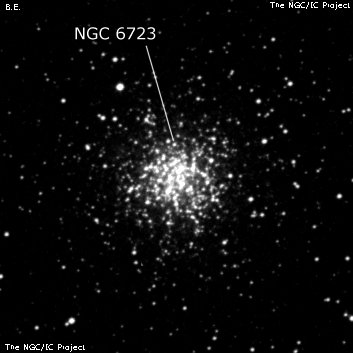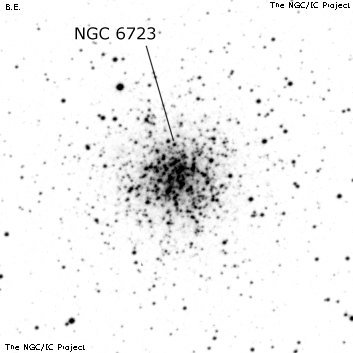NGC/IC Project Restoration Effort
(This is a very very beta version)
NGC6723


Basic Information
Location and Magnitude
Right Ascension: 18:59:33.2
Declination: -36:37:52
Constellation: SGR
Visual Magnitude: 6.8
Historic Information
Discoverer: Dunlop
Year of discovery: 1826
Discovery aperture: 9.0
Observational
Summary description: globular, vL, vlE, vgbM, rrr, st 14…16
Sub-type: VII
Steve's Notes
=====
NGC 6723
18" (7/10/02 - Magellan Observatory, Australia): very bright, beautiful symmetric globular at 128x. The halo measures 7' with a sharply concentrated, blazing 3' core. Roughly 100 stars are resolved with a strong impression the core would more fully resolve using a higher magnification. A single mag 10.5 star is at the NE edge of the halo.
17.5" (6/30/00): this is a beautiful, symmetric GC at 220x. The halo extends to ~6' and is sharply concentrated with a very bright 3' core. This core is highly resolved into a dense overlay of faint stars with a single brighter star just north of center. The extent of the halo is ill-defined and consists of numerous brighter stragglers (or field stars) mixed with a sprinkling of dim stars. Perhaps 70 stars are resolved in total. In a remarkable region with a complex of unusual reflection nebulae (NGC 6726/27/29).
17.5" (7/29/92): at 220x, bright, fairly large with about 50 stars visible in a 4'-5' diameter. Fairly symmetric appearance with no distinct edge. Beautifully resolved into several dozen stars. A mag 10.5 star is off the NE edge 3' from the core. Mildly concentrated but no distinct nucleus although a star appears embedded at the center of the core. The outer halo is well-resolved and a peppering of stars is resolved over the core. In the same low power field with bright nebula NGC 6726, NGC 6727, NGC 6729 to the SE!
13.1" (8/24/84): at 220x many faint stars resolved beyond the main disc.
13.1" (5/26/84): bright, large, mottled, many faint stars resolved across disc and at edges of halo.
13.1" (8/15/82): a number of very faint stars resolved around the periphery at 140x.
8" (7/31/81): bright, large, bright core, mottled, some resolution of extremely faint stars around edges.
10x30 (8/8/04 - Haleakala Crater): fairly bright in binoculars, situated just north of the top of the looping curve forming Corona Australis.



